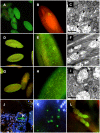Infectious speciation revisited: impact of symbiont-depletion on female fitness and mating behavior of Drosophila paulistorum
- PMID: 21151959
- PMCID: PMC2996333
- DOI: 10.1371/journal.ppat.1001214
Infectious speciation revisited: impact of symbiont-depletion on female fitness and mating behavior of Drosophila paulistorum
Abstract
The neotropical Drosophila paulistorum superspecies, consisting of at least six geographically overlapping but reproductively isolated semispecies, has been the object of extensive research since at least 1955, when it was initially trapped mid-evolution in flagrant statu nascendi. In this classic system females express strong premating isolation patterns against mates belonging to any other semispecies, and yet uncharacterized microbial reproductive tract symbionts were described triggering hybrid inviability and male sterility. Based on theoretical models and limited experimental data, prime candidates fostering symbiont-driven speciation in arthropods are intracellular bacteria belonging to the genus Wolbachia. They are maternally inherited symbionts of many arthropods capable of manipulating host reproductive biology for their own benefits. However, it is an ongoing debate as to whether or not reproductive symbionts are capable of driving host speciation in nature and if so, to what extent. Here we have reevaluated this classic case of infectious speciation by means of present day molecular approaches and artificial symbiont depletion experiments. We have isolated the α-proteobacteria Wolbachia as the maternally transmitted core endosymbionts of all D. paulistorum semispecies that have coevolved towards obligate mutualism with their respective native hosts. In hybrids, however, these mutualists transform into pathogens by overreplication causing embryonic inviability and male sterility. We show that experimental reduction in native Wolbachia titer causes alterations in sex ratio, fecundity, and mate discrimination. Our results indicate that formerly designated Mycoplasma-like organisms are most likely Wolbachia that have evolved by becoming essential mutualistic symbionts in their respective natural hosts; they have the potential to trigger pre- and postmating isolation. Furthermore, in light of our new findings, we revisit the concept of infectious speciation and discuss potential mechanisms that can restrict or promote symbiont-induced speciation at post- and prezygotic levels in nature and under artificial laboratory conditions.
Conflict of interest statement
The authors have declared that no competing interests exist.
Figures






References
-
- Coyne JA, Orr HA. Sunderland, MA: Sinauer Associates; 2004. Speciation.545
-
- Dobzhansky T. New York: Columbia University Press; 1937. Genetic and the Origin of Species.364
-
- Muller HJ. Isolating mechanisms, evolution, and temperature. Biol Symp. 1942;6:71–125.
-
- Brideau NJ, Flores HA, Wang J, Maheshwari S, Wang X, et al. Two Dobzhansky-Muller genes interact to cause hybrid lethality in Drosophila. Science. 2006;314:1238–1239. - PubMed
-
- Dover G. Molecular drive: a cohesive mode of species evolution. Nature. 1982;299:111–117. - PubMed
Publication types
MeSH terms
Grants and funding
LinkOut - more resources
Full Text Sources
Other Literature Sources
Molecular Biology Databases

